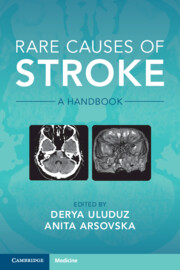Book contents
- Rare Causes of Stroke
- Rare Causes of Stroke
- Copyright page
- Contents
- Contributors
- Preface
- 1 Inflammatory Conditions
- Chapter 1.1 Isolated Vasculitis of the Central Nervous System
- Chapter 1.2 Primary Systemic Vasculitis
- Chapter 1.3 Vasculitis Secondary to Systemic Disease
- Chapter 1.2 Chapter
- 2 Infectious and Postinfectious Vasculitis
- 3 Hypercoagulable Causes of Stroke
- 4 Drug-Related Stroke
- 5 Hereditary and Genetic Causes of Stroke
- 6 Rare Causes of Cardioembolism
- 7 Vasospastic Conditions and Other Vasculopathies
- 8 Other Non-inflammatory Vasculopathies
- 9 Venous Occlusive Conditions
- 10 Bone Disorders and Stroke
- Index
- References
Chapter 1.2 - Chapter
from 1 - Inflammatory Conditions
Published online by Cambridge University Press: 06 October 2022
- Rare Causes of Stroke
- Rare Causes of Stroke
- Copyright page
- Contents
- Contributors
- Preface
- 1 Inflammatory Conditions
- Chapter 1.1 Isolated Vasculitis of the Central Nervous System
- Chapter 1.2 Primary Systemic Vasculitis
- Chapter 1.3 Vasculitis Secondary to Systemic Disease
- Chapter 1.2 Chapter
- 2 Infectious and Postinfectious Vasculitis
- 3 Hypercoagulable Causes of Stroke
- 4 Drug-Related Stroke
- 5 Hereditary and Genetic Causes of Stroke
- 6 Rare Causes of Cardioembolism
- 7 Vasospastic Conditions and Other Vasculopathies
- 8 Other Non-inflammatory Vasculopathies
- 9 Venous Occlusive Conditions
- 10 Bone Disorders and Stroke
- Index
- References
Summary
A 49-year-old female patient was admitted to the emergency room with the left-sided frust hemiparesis and hemihypoesthesia. She has been experiencing intermittent cough, general weakness, and body pain for the past year. Cranial diffusion magnetic resonance imaging (MRI) revealed an acute infarct in the right occipital lobe. Chest X-ray showed bilateral hilar fullness. Mediastinal lymphadenopathy, bilateral micronodular parenchymal infiltrations, thickening of the major fissure and multiple linear reticulonodular patterns were observed on high-resolution computerized tomography (HRCT). Laboratory tests showed a sedimentation rate of 44 mm/1 h; positivity for SS-A, SS-B, Ro-52 recombinant AMA-M2 (+++) direct Coombs IgG, anti-beta-2 glycoprotein 1 IgG and high serum ACE (angiotensin converting enzyme) level. Fluorodeoxyglucose (FDG)-positron emission tomography (PET)/CT showed pathological uptake in the mediastinal and abdominal lymph nodes, ground-glass opacity infiltration located in the bilateral lungs and intramedullary bone uptake. Bone marrow biopsy revealed noncaseating granulomas. With the diagnosis of neurosarcoidosis (NS), oral corticosteroid and azathioprine were administered. Sarcoidosis is a chronic, idiopathic, inflammatory and granulomatous disease with multisystem involvement. Noncaseating epithelioid granulomas are the most characteristic findings. NS frequently occurs in patients with active disease and systemic involvement. A sarcoidosis patient may develop neurological symptoms, or the initial symptom of a patient may be typical for NS. Very rare presentations of NS are ischaemic stroke, transient ischaemic attacks (TIAs), intracranial haemorrhage and venous thrombosis. NS should be considered especially in young patients, experiencing recurrent TIAs, ischaemic or haemorrhagic strokes, and having MRI findings suggestive of NS
- Type
- Chapter
- Information
- Rare Causes of StrokeA Handbook, pp. 85 - 91Publisher: Cambridge University PressPrint publication year: 2022



